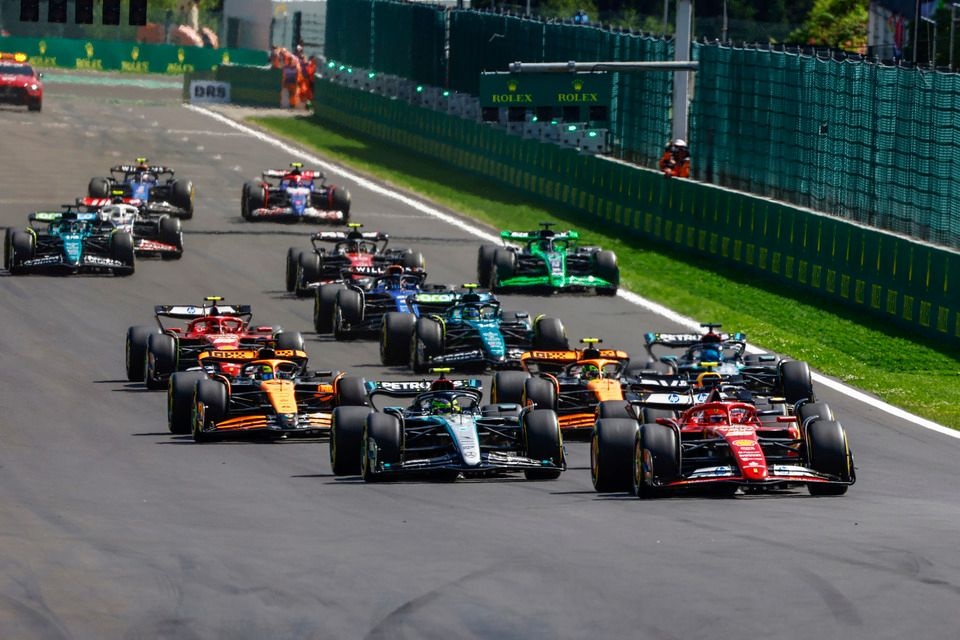Despite taking an utterly dominant Formula 1 sprint pole at the Belgian Grand Prix, McLaren’s Oscar Piastri wasn’t getting too excited just yet over his victory chances on Saturday morning.
“Spa’s probably one of the worst places to have pole position, so yeah… it is what it is,” a muted Australian said after beating Max Verstappen by five tenths, and team-mate Lando Norris by six. “But I think the pace in the car all day has been really strong and I’ve felt very confident. So, hopefully we can get a good start and try and win the sprint.”
With its long straights on the run up to Turn 5’s Les Combes, punctuated by the Eau Rouge – Raidillon combination, Piastri is expecting to have a big challenge on his hands to keep his lead against the chasing Verstappen and Norris.
But are Piastri’s fears justified? Perhaps not so much if you look at recent history. Since 2017 the lead only changed hands twice on lap one; in 2018 when Sebastian Vettel pulled off a slingshot around Lewis Hamilton, and in 2023 when polesitter Charles Leclerc was passed by Red Bull’s Sergio Perez into Les Combes.
Ignoring the shambolic, rained out 2021 edition and the wet 2023 sprint, the polesitter has successfully defended his lead in all other editions, with it having been more common for the second-placed driver to come under pressure instead.
Lead changes at the start at Spa
| Year | Top three on the grid | Top three after lap one |
| 2017 | Hamilton, Vettel, Bottas | Hamilton, Vettel, Bottas |
| 2018 | Hamilton, Vettel, Ocon | Vettel, Hamilton, Perez |
| 2019 | Leclerc, Vettel, Hamilton | Leclerc, Vettel, Hamilton |
| 2020 | Hamilton, Bottas, Verstappen | Hamilton, Bottas, Verstappen |
| 2022 | Sainz, Perez, Alonso | Sainz, Perez, Russell |
| 2023 | Leclerc, Perez, Hamilton | Perez, Leclerc, Hamilton |
| 2024 | Sainz, Perez, Hamilton | Sainz, Hamilton, Perez |
The Max factor
Verstappen has been mired in the midfield during recent Spa starts
Photo by: Steven Tee / Motorsport Images
But there are a number of caveats that are distorting this small sample size, such as Perez twice having a terrible start from second in 2022 and 2024 and Verstappen not having been in the frame over the past three years as Red Bull has built up something of a tradition to take engine penalties in Belgium.
Not so this year, and what’s more Red Bull – as at Silverstone – has opted for a lower downforce set-up compared to its rivals to benefit overall lap time, even if it is shipping time in slower corners.
McLaren brought an impressive looking rear wing upgrade that has made its car more aerodynamically efficient, so it can run more downforce with a smaller drag penalty on the straight. But, with Verstappen’s set-up, the RB21 is still an average of 4km/h faster on the long Kemmel Straight towards Les Combes, and on the run from Blanchimont to the Bus Stop chicane.
A look at the telemetry shows Verstappen really only loses time in the slower corners, such as Bruxelles, Fagnes, Stavelot and the chicane, shipping four tenths of his five-tenth deficit in sector two’s Fagnes and Stavelot alone. That trade-off is bigger than Red Bull expected, Helmut Marko told Autosport. “We thought we would be closer, but in sector two we are just losing four tenths,” he said. “Not only us, but all the other drivers are also losing this amount and even more. We made a step forward, but obviously it’s not enough to fight Piastri.”
But, if Verstappen does get ahead on the straight, will he be able to make life difficult for the McLaren to find a way back past, like he did in Japan? With McLaren’s pace advantage and superior tyre management in mind, the Dutchman is not convinced.
“I mean, when you’re almost five tenths off, I don’t think going faster or slower on the straight is going to matter a lot,” he said. “We just have to do our own race and see what we can do.”
In this article
Be the first to know and subscribe for real-time news email updates on these topics
Read the full article here

